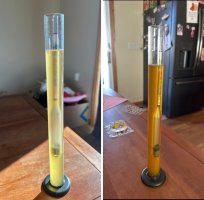NewBrewer2025
Active Member
So, I made the leap of faith and ordered a Anvil Foundry 10.5. I am moving to all-grain to have some greater control over my beer. Well, I will still be doing some 1 to 2 gallon extract batches as well, but this will be for my 3-5 gallon batches.
And so.. for my first all-grain beer, I have decided to do a little "experiment" and make a recipe similar to what my first extract brew was - a light golden ale. Except... I am hoping to actually get a light color and not have the caramel flavor I got from that extract. I actually ended up really liking that flavor, but.. I want to actually make what I intended to make.
The 5 gallon extract kit was:
Here is my 3 gallon all-grain recipe I’m going to attempt, which I had Brewfather scale down for me from 5 gallons;
Any thoughts? I'm open to any help and advice, as this is clearly so new to me!
And so.. for my first all-grain beer, I have decided to do a little "experiment" and make a recipe similar to what my first extract brew was - a light golden ale. Except... I am hoping to actually get a light color and not have the caramel flavor I got from that extract. I actually ended up really liking that flavor, but.. I want to actually make what I intended to make.
The 5 gallon extract kit was:
- 3.3 lbs golden light LME
- 1.0 pounds golden light DME
- 1.0 rice solids
- 1 lbs Munich malt (steeping grains)
- 60 minute boil of Tettanger Hops, 5 minute boil Cascade hops
- Safale US-05
Here is my 3 gallon all-grain recipe I’m going to attempt, which I had Brewfather scale down for me from 5 gallons;
- 4 lb 10oz Pilsner Malt (76.5%)
- 11.4 oz Munich Malt (11.7%
- 11.4 oz Flaked Rice (11.7%)
- 0.5 oz Tettanger 60 minutes, and then 0.5 oz Cascade for 5 minutes
- Also going to add a whirlfloc tablet with 5 minutes in boil, and clarity ferm when pitching yeast
- 60 minute mash at 150
- Mash out at 170? Unsure if I am going to do the extra steps like this on my first brew or not, but it seems easy enough with an AIO electric kettle, so why not?
Any thoughts? I'm open to any help and advice, as this is clearly so new to me!




![Craft A Brew - Safale S-04 Dry Yeast - Fermentis - English Ale Dry Yeast - For English and American Ales and Hard Apple Ciders - Ingredients for Home Brewing - Beer Making Supplies - [1 Pack]](https://m.media-amazon.com/images/I/41fVGNh6JfL._SL500_.jpg)






















































